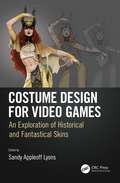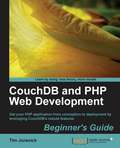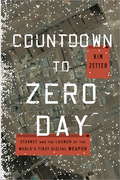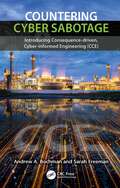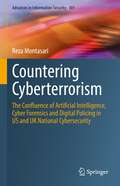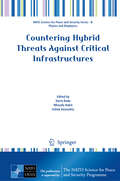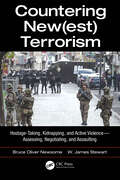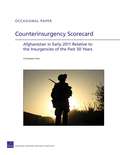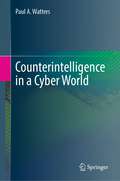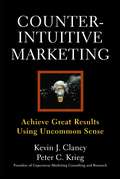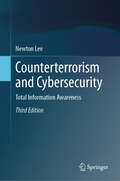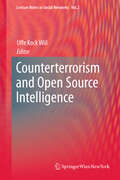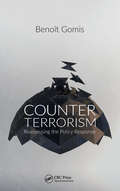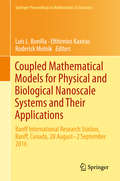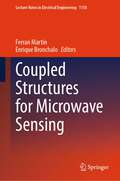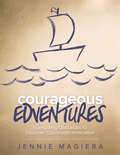- Table View
- List View
Costume Design for Video Games: An Exploration of Historical and Fantastical Skins
by Sandy Appleoff LyonsCostume Design for Video Games: An Exploration of Historical and Fantastical Skins explores the rich and colorful history of fashion throughout the ages. Each page goes into detail concerning the social significance of Iconic period pieces. From the real and the imagined, Costume Design for Video Games highlights the development of costumes and characters that pertain to plots, scenarios, and visionary goals, while also exploring silhouettes and the aesthetics of various eras. This survey of costume design for the video game market includes an exploration of the aesthetics of historical, fantasy, and futuristic influences. Not only does the text help in illustrating an assortment of styles, but Sandy Appleoff Lyons also helps to facilitate creative problem-solving as it applies to costume design and the design principles applied. This is uniquely done through a reader project, which in turn builds and implements research skills and the creation of authentic designs. Key Features: This book is not about replicating what already exists; it gives the reader the tools needed in order to understand the design principles and how to apply them to costumes. Through the comprehensive understanding of history, fashion, costumes, and cultural impacts, the readers will be able to expand their creativity and knowledge to help increase the narrative subtext and the stories of costumed figures. Readers are given tools for creative problem-solving to create authentic, original costumes. Text includes a glossary and sidebars covering materials rendering, color history, design principles, and meaning. Key terms and style sheets with layout training and cited historical examples help ground the reader with strong visuals.
CouchDB and PHP Web Development Beginner’s Guide
by Tim JuravichEach chapter follows the creation of a social networking application with step-by-step instructions. This means that you will have easily created a complete, working application by the end of the book. This book is for beginner and intermediate PHP developers interested in using CouchDB development in their projects. Advanced PHP developers will appreciate the familiarity of the PHP architecture and can easily learn how to incorporate CouchDB into their existing development experiences.
CouchDB: Time to Relax (Animal Guide)
by J. Chris Anderson Jan Lehnardt Noah SlaterThree of CouchDB's creators show you how to use this document-oriented database as a standalone application framework or with high-volume, distributed applications. With its simple model for storing, processing, and accessing data, CouchDB is ideal for web applications that handle huge amounts of loosely structured data. That alone would stretch the limits of a relational database, yet CouchDB offers an open source solution that's reliable, scales easily, and responds quickly.CouchDB works with self-contained data that has loose or ad-hoc connections. It's a model that fits many real-world items, such as contacts, invoices, and receipts, but you'll discover that this database can easily handle data of any kind. With this book, you'll learn how to work with CouchDB through its RESTful web interface, and become familiar with key features such as simple document CRUD (create, read, update, delete), advanced MapReduce, deployment tuning, and more.Understand the basics of document-oriented storage and manipulationInteract with CouchDB entirely though HTTP using its RESTful interfaceModel data as self-contained JSON documentsHandle evolving data schemas naturallyQuery and aggregate data in CouchDB using MapReduce viewsReplicate data between nodesTune CouchDB for increased performance and reliability
Couchbase Essentials
by John ZablockiThis book is for those application developers who want to achieve greater flexibility and scalability from their software. Whether you are familiar with other NoSQL databases or have only used relational systems, this book will provide you with enough background to move you along at your own pace. If you are new to NoSQL document databases, the design discussions and introductory material will give you the information you need to get started with Couchbase.
Counsellor Competencies: Developing Counselling Skills for Education, Career and Occupation
by Bernd-Joachim Ertelt William E. Schulz Andreas FreyCareer and student counselling is a complex task that requires a high level of professionalism. This book introduces basic counselling skills in vocational and educational guidance. It is based on important scientific models. The book presents internationally recognized counselling approaches which include among others micro counselling, solution focused brief counselling and competence oriented counselling. It also addresses possibilities for the use of artificial intelligence. The book offers direct guidance for the consulting practice and supports competence development through case studies, tasks and didactically designed exercises. It is suitable as a guide for the training of consulting professionals in the field of career guidance.
Countdown Crisis (Open World Squad)
by Michael Anthony SteeleThe gamer squad is on an Open World quest to save Atlantis from sea monsters! Thirteen-year-old Kai isn’t thrilled about this underwater level. He usually takes a background role managing the group’s supplies, but now he’s vital in giving out air refills or else it’s game over. Worse, Kai is feeling even more pressure IRL with an upcoming oral presentation at school. With help from the squad, can Kai figure out how to breathe deep and work through his anxiety? Game on with Open World Squad, an illustrated hi-lo chapter book series featuring exciting video game action and a winning mix of easy-to-read narrative text and in-game chat conversations.
Countdown to Zero Day: Stuxnet and the Launch of the World's First Digital Weapon
by Kim ZetterTop cybersecurity journalist Kim Zetter tells the story behind the virus that sabotaged Iran's nuclear efforts and shows how its existence has ushered in a new age of warfare--one in which a digital attack can have the same destructive capability as a megaton bomb. In January 2010, inspectors with the International Atomic Energy Agency noticed that centrifuges at an Iranian uranium enrichment plant were failing at an unprecedented rate. The cause was a complete mystery--apparently as much to the technicians replacing the centrifuges as to the inspectors observing them. Then, five months later, a seemingly unrelated event occurred: A computer security firm in Belarus was called in to troubleshoot some computers in Iran that were crashing and rebooting repeatedly. At first, the firm's programmers believed the malicious code on the machines was a simple, routine piece of malware. But as they and other experts around the world investigated, they discovered a mysterious virus of unparalleled complexity. They had, they soon learned, stumbled upon the world's first digital weapon. For Stuxnet, as it came to be known, was unlike any other virus or worm built before: Rather than simply hijacking targeted computers or stealing information from them, it escaped the digital realm to wreak actual, physical destruction on a nuclear facility. In these pages, Wired journalist Kim Zetter draws on her extensive sources and expertise to tell the story behind Stuxnet's planning, execution, and discovery, covering its genesis in the corridors of Bush's White House and its unleashing on systems in Iran--and telling the spectacular, unlikely tale of the security geeks who managed to unravel a sabotage campaign years in the making. But Countdown to Zero Day ranges far beyond Stuxnet itself. Here, Zetter shows us how digital warfare developed in the US. She takes us inside today's flourishing zero-day "grey markets," in which intelligence agencies and militaries pay huge sums for the malicious code they need to carry out infiltrations and attacks. She reveals just how vulnerable many of our own critical systems are to Stuxnet-like strikes, from nation-state adversaries and anonymous hackers alike--and shows us just what might happen should our infrastructure be targeted by such an attack. Propelled by Zetter's unique knowledge and access, and filled with eye-opening explanations of the technologies involved, Countdown to Zero Day is a comprehensive and prescient portrait of a world at the edge of a new kind of war.
Counter Terrorism Issues: Case Studies in the Courtroom
by James Ottavio CastagneraThe American legal profession and judicial system bear a unique responsibility to set and maintain the balance between defending homeland security and protecting the civil liberties outlined in the Bill of Rights. These competing interests will continue to collide as the threats to our safety grow. Exploring the most significant terrorist cases of
Counter Terrorism Issues: Case Studies in the Courtroom
by James Ottavio CastagneraCounter Terrorism Issues: Case Studies in the Courtroom, Second Edition presents a panoramic view of the American judiciary’s handling of domestic terrorism in the last 30 years. As has played out in recent history, the American legal profession and judicial system bear a unique responsibility to set and maintain the balance between defending homeland security and protecting the civil liberties outlined in the Bill of Rights. These competing interests will continue to collide as the threats to our safety grow.The book examines some of the most notorious cases—the two attacks on the World Trade Center, the Oklahoma City bombing, and the Fort Hood massacre. Updates from the First Edition include a reflection on the Boston Marathon bombing, as well as an examination of the events of January 6, 2021, the subsequent legal proceedings and convictions of those involved in the assault on the U.S. Capitol, and the danger arising from increased domestic extremism and violent rhetoric from the right.Drawing extensively upon trial transcripts, witness statements, and judicial opinions, the book reviews the events and cases to demonstrate how the criminal justice system has grappled with conflicting facts and countervailing legal rights and responsibilities. Through the words of witnesses, judges, and the attorneys who tried these cases in America’s courtrooms, coverage provides important commentary on the historical/political contexts of these events, enabling readers to understand the significance of these infamous attacks on U.S. soil.
Countering Brandjacking in the Digital Age: … and Other Hidden Risks to Your Brand (SpringerBriefs in Computer Science)
by Christopher Hofman Simeon KeatesThe rise of the Internet and social media in particular offer great opportunities for brand owners to increase business and brand recognition. While this has clearly been of benefit to brand owners, who have seen a consequent rise in the value of their brands, it simultaneously makes those brands more attractive for exploitation or attack by others. Brand risks can come in many different types and this book provides examples of how these risks can arise as well as providing quantitative estimates of the adverse impacts that can result from such risks. Brand owners need to be aware of the risks and of the need to develop strategies for identifying and managing them. This book details the process by which a brand owner can develop a brand risk management process to protect a brand's reputation and value. Rather than prescribe a one-size-fits-all approach, the authors provide guidance on how a brand risk management process can be tailored to particular needs and circumstances. This approach is underpinned by drawing on examples of best practice in the fields of risk management, interaction design and engineering design. This combined approach relies on developing an understanding of the risks faced by a particular brand owner, the full context of those risks and also the brand owner's capabilities for identifying and managing those risks. This book contains many real-world examples and interviews with a number of brand owning organisations ranging from small companies to large multinationals.
Countering Cyber Sabotage: Introducing Consequence-Driven, Cyber-Informed Engineering (CCE)
by Sarah Freeman Andrew A. BochmanCountering Cyber Sabotage: Introducing Consequence-Driven, Cyber-Informed Engineering (CCE) introduces a new methodology to help critical infrastructure owners, operators and their security practitioners make demonstrable improvements in securing their most important functions and processes. Current best practice approaches to cyber defense struggle to stop targeted attackers from creating potentially catastrophic results. From a national security perspective, it is not just the damage to the military, the economy, or essential critical infrastructure companies that is a concern. It is the cumulative, downstream effects from potential regional blackouts, military mission kills, transportation stoppages, water delivery or treatment issues, and so on. CCE is a validation that engineering first principles can be applied to the most important cybersecurity challenges and in so doing, protect organizations in ways current approaches do not. The most pressing threat is cyber-enabled sabotage, and CCE begins with the assumption that well-resourced, adaptive adversaries are already in and have been for some time, undetected and perhaps undetectable. Chapter 1 recaps the current and near-future states of digital technologies in critical infrastructure and the implications of our near-total dependence on them. Chapters 2 and 3 describe the origins of the methodology and set the stage for the more in-depth examination that follows. Chapter 4 describes how to prepare for an engagement, and chapters 5-8 address each of the four phases. The CCE phase chapters take the reader on a more granular walkthrough of the methodology with examples from the field, phase objectives, and the steps to take in each phase. Concluding chapter 9 covers training options and looks towards a future where these concepts are scaled more broadly.
Countering Cyberterrorism: The Confluence of Artificial Intelligence, Cyber Forensics and Digital Policing in US and UK National Cybersecurity (Advances in Information Security #101)
by Reza MontasariThis book provides a comprehensive analysis covering the confluence of Artificial Intelligence (AI), Cyber Forensics and Digital Policing in the context of the United Kingdom (UK), United States (US) and European Union (EU) national cybersecurity. More specifically, this book explores ways in which the adoption of AI algorithms (such as Machine Learning, Deep Learning, Natural Language Processing, and Big Data Predictive Analytics (BDPAs) transforms law enforcement agencies (LEAs) and intelligence service practices. It explores the roles that these technologies play in the manufacture of security, the threats to freedom and the levels of social control in the surveillance state. This book also examines the malevolent use of AI and associated technologies by state and non-state actors. Along with this analysis, it investigates the key legal, political, ethical, privacy and human rights implications of the national security uses of AI in the stated democracies. This book provides a set of policy recommendations to help to mitigate these challenges. Researchers working in the security field as well advanced level students in computer science focused on security will find this book useful as a reference. Cyber security professionals, network security analysts, police and law enforcement agencies will also want to purchase this book.
Countering Hybrid Threats Against Critical Infrastructures (NATO Science for Peace and Security Series B: Physics and Biophysics)
by Ashok Vaseashta Dorin Radu Mirsada HukićThis proceedings volume presents a collection of articles from key practitioners from relevant areas with experience in critical infrastructure. The authors acknowledge that the responsibility for critical infrastructure protection is primarily a matter of international importance, hence a high degree of cross-border and cross-sectoral interdependencies must be coordinated or, where appropriate, legally harmonized efforts at the international level, including the smooth functioning of the internal policies. The book focuses on countering hybrid threats that render critical infrastructures vulnerable. An understanding of such threats will render critical infrastructure safe, secure, and resilient. The protection of national critical infrastructures, as well as of the functions and services critical to the proper functioning of society is a key priority and requires a new unique and strategic approach. Work in this direction must consider the strong interdependencies between the various critical functions and services, including financial services, the key role of the private sector, the changing security environment, and emerging risks, both in the physical and cyber fields. In addition to legal requirements, agreements should be promoted with private sector infrastructure and service owners and operators to ensure the continuity of and access to critical services, including beyond force majeure, by ensuring an acceptable level of preparedness to respond. all relevant threats, as well as the flexibility to address and mitigate the effects of low-probability, high-impact events.
Countering New(est) Terrorism: Hostage-Taking, Kidnapping, and Active Violence — Assessing, Negotiating, and Assaulting
by Bruce Oliver Newsome James W. StewartHow should we analyze and assess new terrorist behaviors? What are the particular risks and challenges from new terrorism? Should we negotiate with terrorists, and, if so, how? When should we use force against terrorists? Countering New(est) Terrorism: Hostage-Taking, Kidnapping, and Active Violence—Assessing, Negotiating, and Assaulting improves our knowledge of new terrorist behaviors, and our skills in responding to such attacks.The term "new terrorism" has been in circulation since the late 90’s. This book analyzes the "newest terrorism" that has emerged in recent years—characterized by increased hostage-taking, kidnapping, and active violence—and develops best practices for countering these emerging threats. Along the way, it challenges fashionable wishful thinking that all terrorists are open to rational negotiation or de-radicalization, that military responses always reflect badly on the official side, and that terrorists are not constrained by their own doctrines.The new terrorists are dramatically more ideological, murderous, and suicidal. They are generally less reconcilable, less trusting of official negotiators, less likely to release detainees, and more likely to kill detainees. They are less likely to demand ransoms yet more likely to release hostages in cases in which they do demand ransom. They are more informed about the official side’s policies, tactics, techniques, and procedures. They are more likely to use new information and communication technologies against responding agencies and officials. They are more capable fighters—they kill more people despite deploying fewer fighters per hostage. Most disturbing is the fact that they take advantage of free-er societies to access easier targets. Features: Includes evidence-based definitions and descriptions of political, religious, Jihadi, and new terrorism Presents the first large-n comparison of old and new terrorism, using an original extension of the Global Terrorism Database (GTD), with added codes for each of 10,735 hostage crises and more than 500,000 data points from 1970 through 2016 Details a further extension of the GTD covering all terrorist events from 2004 through 2016, roughly 5 million data points. Offers prescriptive advice and visual decision trees on how to negotiate crises, assess the risk of terrorism, and how and when to assault terrorists Reviews official practices, interviews with experienced officials, and real-world simulations of recent terrorist events and attacks Countering New(est) Terrorism will be of interest to researchers, students enrolled in terrorism and Homeland Security programs, crisis negotiators, and police, security, intelligence, and military authorities tasked with counterterrorism and anti-terrorism efforts.
Counterinsurgency Scorecard: Afghanistan In Early 2011 Relative to the Insurgencies of the Past 30 Years
by Christopher PaulA core finding of previous RAND research on 30 years of insurgencies worldwide was that a conflict's overall score on a scorecard of 15 equally weighted good and 12 equally weighted bad counterinsurgency factors and practices perfectly predicted the ultimate outcome. Using the scorecard approach and an expert elicitation (Delphi) exercise, a RAND project sought to extend the findings to the case of Afghanistan in early 2011.
Counterintelligence in a Cyber World
by Paul A. WattersThis book provides an outline of the major challenges and methodologies for applying classic counterintelligence theory into the cybersecurity domain. This book also covers operational security approaches to cyber, alongside detailed descriptions of contemporary cybersecurity threats, in the context of psychological and criminal profiling of cybercriminals. Following an analysis of the plethora of counterespionage techniques that can be mapped to the cyber realm, the mechanics of undertaking technical surveillance are reviewed.A range of approaches to web and forum surveillance are outlined as a virtual addition to traditional video and audio surveillance captured regarding targets. This includes a description of the advances in Artificial Intelligence, predictive analysis, support for the disciplines of digital forensics, behavioural analysis and Open Source Intelligence (OSINT). The rise of disinformation and misinformation and the veracity of widespread false flag claims are discussed at length, within the broader context of legal and ethical issues in cyber counterintelligence.This book is designed for professionals working in the intelligence, law enforcement or cybersecurity domains to further explore and examine the contemporary intersection of these disciplines. Students studying cybersecurity, justice, law, intelligence, criminology or related fields may also find the book useful as a reference volume, while instructors could utilise the whole volume or individual chapters as a secondary textbook or required reading.
Counterintuitive Marketing: Achieving Great Results Using Common Sense
by Kevin J. Clancy Peter C. KriegWhy does American business seem to sputter along where it ought to thrive? What is the source of the current plague of downsizing, disappearing companies, dot-com crashes, and here-today-gone-tomorrow advertising campaigns? Why do more products flop than ever before? Marketing experts Kevin J. Clancy and Peter C. Krieg have the answers. In Counterintuitive Marketing, Clancy and Krieg trace the high rate of business failure back to bad marketing strategy, and the even worse implementation of that strategy. Excess testosterone, they argue, compels senior managers to make decisions intuitively, instinctively, quickly, and, unfortunately, disastrously. In this informative and enlightening book, Clancy and Krieg confront these "over-and-over-again" marketers, who don't have time to do it right the first time, but endless time and a company bankroll to do it wrong over and over again. The authors draw from their decades of consumer and business-to-business marketing experience to describe the intuitive decision-making practices that permeate business today, and demonstrate how these practices lead to disappointing performance. Chapter by chapter, Counterintuitive Marketing contrasts how marketing decisions are made today with how they should be made. The authors give equal treatment to targeting, positioning, product development, pricing, customer service, e-commerce, marketing planning, implementation, and more as they present counterintuitive ideas for building and introducing blockbuster marketing programs. Readers will discover in this iconoclastic treasure chest hundreds of penetrating insights that have enabled the authors' firm, Copernicus, to transform companies and become a "brand guardian" to the Fortune 500 and emerging businesses around the world. The tools to create exceptional marketing programs really do exist, and they are all here in Counterintuitive Marketing, the ultimate practical guide for any company of any size.
Counterterrorism and Cybersecurity: Total Information Awareness
by Newton LeeImagine James Bond meets Sherlock Holmes: Counterterrorism and Cybersecurity is the sequel to Facebook Nation in the Total Information Awareness book series by Newton Lee. The book examines U.S. counterterrorism history, technologies, and strategies from a unique and thought-provoking approach that encompasses personal experiences, investigative journalism, historical and current events, ideas from great thought leaders, and even the make-believe of Hollywood. Demystifying Total Information Awareness, the author expounds on the U.S. intelligence community, artificial intelligence in data mining, social media and privacy, cyber attacks and prevention, causes and cures for terrorism, and longstanding issues of war and peace. The book offers practical advice for businesses, governments, and individuals to better secure the world and protect cyberspace. It quotes U.S. Navy Admiral and NATO's Supreme Allied Commander James Stavridis: "Instead of building walls to create security, we need to build bridges." The book also provides a glimpse into the future of Plan X and Generation Z, along with an ominous prediction from security advisor Marc Goodman at TEDGlobal 2012: "If you control the code, you control the world." Counterterrorism and Cybersecurity: Total Information Awareness will keep you up at night but at the same time give you some peace of mind knowing that "our problems are manmade -- therefore they can be solved by man [or woman]," as President John F. Kennedy said at the American University commencement in June 1963.
Counterterrorism and Cybersecurity: Total Information Awareness
by Newton LeeCounterterrorism and cybersecurity are the top two priorities at the Federal Bureau of Investigation (FBI). Graduated from the FBI Citizens Academy in 2021, Prof. Newton Lee offers a broad survey of counterterrorism and cybersecurity history, strategies, and technologies in the 3rd edition of his riveting book that examines the role of the intelligence community, cures for terrorism, war and peace, cyber warfare, and quantum computing security. From September 11 attacks and Sony-pocalypse to Israel’s 9/11 and MOAB (Mother of All Breaches), the author shares insights from Hollywood such as 24, Homeland, The Americans, and The X-Files. In real life, the unsung heroes at the FBI have thwarted a myriad of terrorist attacks and cybercrimes. The FBI has worked diligently to improve its public image and build trust through community outreach and pop culture. Imagine Sherlock Holmes meets James Bond in crime fighting, FBI Director Christopher Wray says, “We’ve got technically trained personnel—with cutting-edge tools and skills you might never have imagined seeing outside of a James Bond movie—covering roughly 400 offices around the country.” This book is indispensable for anyone who is contemplating a career at the FBI, think tanks, or law enforcement agencies worldwide. It is also a must-read for every executive to safeguard their organization against cyberattacks that have caused more than $10 billion in damages. In the spirit of President John F. Kennedy, one may proclaim: “Ask not what counterterrorism and cybersecurity can do for you, ask what you can do for counterterrorism and cybersecurity.” Praise for the First Edition: “The book presents a crisp narrative on cyberattacks and how to protect against these attacks. … The author views terrorism as a disease that may be cured through education and communication. … The book is a relevant, useful, and genial mix of history, current times, practical advice, and policy goals.” - Brad Reid, ACM Computing Reviews “Very professional and well researched.” - Eleanor Clift, Newsweek and The Daily Beast
Counterterrorism and Open Source Intelligence (Lecture Notes in Social Networks #2)
by Uffe WiilSince the 9/11 terrorist attacks in the United States, serious concerns were raised on domestic and international security issues. Consequently, there has been considerable interest recently in technological strategies and resources to counter acts of terrorism. In this context, this book provides a state-of-the-art survey of the most recent advances in the field of counterterrorism and open source intelligence, demonstrating how various existing as well as novel tools and techniques can be applied in combating covert terrorist networks. A particular focus will be on future challenges of open source intelligence and perspectives on how to effectively operate in order to prevent terrorist activities.
Counterterrorism: Reassessing the Policy Response
by Benoît GomisCounterterrorism: Reassessing the Policy Response promotes a more nuanced understanding of the effectiveness of current counterterrorism practices and the need for reform. It challenges government, media, and academic accounts that exaggerate terrorist threats, particularly in comparison to other threats such as organized crime. Author Beno�Gomis r
Coupled Mathematical Models for Physical and Biological Nanoscale Systems and Their Applications: Banff International Research Station, Banff, Canada, 28 August - 2 September 2016 (Springer Proceedings in Mathematics & Statistics #232)
by Roderick Melnik Luis L. Bonilla Efthimios KaxirasThis volume gathers selected contributions from the participants of the Banff International Research Station (BIRS) workshop Coupled Mathematical Models for Physical and Biological Nanoscale Systems and their Applications, who explore various aspects of the analysis, modeling and applications of nanoscale systems, with a particular focus on low dimensional nanostructures and coupled mathematical models for their description. Due to the vastness, novelty and complexity of the interfaces between mathematical modeling and nanoscience and nanotechnology, many important areas in these disciplines remain largely unexplored. In their efforts to move forward, multidisciplinary research communities have come to a clear understanding that, along with experimental techniques, mathematical modeling and analysis have become crucial to the study, development and application of systems at the nanoscale. The conference, held at BIRS in autumn 2016, brought together experts from three different communities working in fields where coupled mathematical models for nanoscale and biosystems are especially relevant: mathematicians, physicists (both theorists and experimentalists), and computational scientists, including those dealing with biological nanostructures. Its objectives: summarize the state-of-the-art; identify and prioritize critical problems of major importance that require solutions; analyze existing methodologies; and explore promising approaches to addressing the challenges identified. The contributions offer up-to-date introductions to a range of topics in nano and biosystems, identify important challenges, assess current methodologies and explore promising approaches. As such, this book will benefit researchers in applied mathematics, as well as physicists and biologists interested in coupled mathematical models and their analysis for physical and biological nanoscale systems that concern applications in biotechnology and medicine, quantum information processing and optoelectronics.
Coupled Structures for Microwave Sensing (Lecture Notes in Electrical Engineering #1150)
by Ferran Martín Enrique BronchaloThis book offers a comprehensive and timely review of planar microwave sensors based on coupled structures. Gathering chapters contributed by the most authoritative researchers on this topic, it presents various strategies for sensor performance optimization using coupled lines, directional couplers, and coupled resonators (either distributed or semi-lumped), focusing mainly on sensitivity optimization, and covering chains of coupled resonators as well. The book also reports on analytical methods, design formulas, sensor validation tests, with both simulation and experimental methods, describing some relevant practical applications. Mainly reflecting the research activity carried out by the different contributors in the last years, this book also includes two introductory chapters to help readers who are not very familiar with microwave sensing technologies and coupled structures. All in all, this book addresses advanced graduate students and researchers involved in microwave and sensor technologies, and may be of interest for engineers and professionals as well, working in areas as diverse as wireless sensors and sensor networks, biosensing, chemical sensing, motion control, microfluidics, Internet of Things (IoT), and smart systems.
Courageous Edventures: Navigating Obstacles to Discover Classroom Innovation (Corwin Teaching Essentials)
by Jennie MagieraChart a course to innovation using educational technology Let’s go on an edventure! Do you want to innovate and take risks in your teaching? Looking for ways to troubleshoot common classroom challenges? Whatever obstacles you and your students face can turn into edventures, and this book will show you how to navigate them with grace, humor, and grit. Jennie Magiera charts a course for you to discover your own version of innovation, using the limitless possibilities of educational technology. You will learn: How to create your own Teacher-IEP (Innovation Exploration Plan) Keys to problem-based innovation (PBI) Strategies and solutions for tackling common classroom problems Methods for putting learning into the hands of students How to find innovation in everyday places Packed with real-world, immediately applicable solutions to the problems teachers face in their classrooms every day,Courageous Edventures shows how technology can be a fun and easy tool to improve classroom management and student learning! "Magiera leads people on a journey with some great ideas to get started in the classroom right now, or the inspiration to find your own way, leading to innovative ideas for learning and teaching." George Couros, Author of The Innovator′s Mindset and Innovative Teaching, Learning, and Leadership Consultant "This book does a superb job of providing practical ideas and strategies on how to actually implement innovative practices in today′s classroom. Her knowledge and experience as a change agent further strengthen the techniques presented and will help educators truly envision what′s possible in classrooms today." Eric Sheninger, Corwin Author and Senior Fellow International Center for Leadership in Education
Courageous Edventures: Navigating Obstacles to Discover Classroom Innovation (Corwin Teaching Essentials)
by Jennie MagieraChart a course to innovation using educational technology Let’s go on an edventure! Do you want to innovate and take risks in your teaching? Looking for ways to troubleshoot common classroom challenges? Whatever obstacles you and your students face can turn into edventures, and this book will show you how to navigate them with grace, humor, and grit. Jennie Magiera charts a course for you to discover your own version of innovation, using the limitless possibilities of educational technology. You will learn: How to create your own Teacher-IEP (Innovation Exploration Plan) Keys to problem-based innovation (PBI) Strategies and solutions for tackling common classroom problems Methods for putting learning into the hands of students How to find innovation in everyday places Packed with real-world, immediately applicable solutions to the problems teachers face in their classrooms every day,Courageous Edventures shows how technology can be a fun and easy tool to improve classroom management and student learning! "Magiera leads people on a journey with some great ideas to get started in the classroom right now, or the inspiration to find your own way, leading to innovative ideas for learning and teaching." George Couros, Author of The Innovator′s Mindset and Innovative Teaching, Learning, and Leadership Consultant "This book does a superb job of providing practical ideas and strategies on how to actually implement innovative practices in today′s classroom. Her knowledge and experience as a change agent further strengthen the techniques presented and will help educators truly envision what′s possible in classrooms today." Eric Sheninger, Corwin Author and Senior Fellow International Center for Leadership in Education
